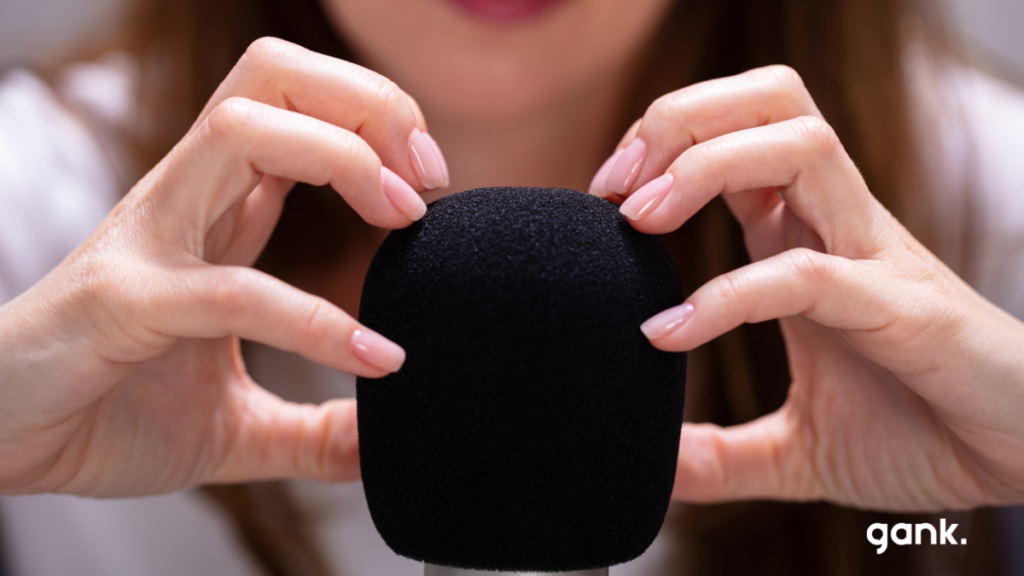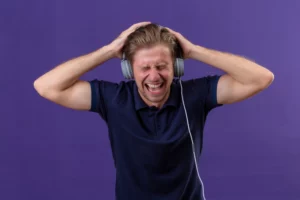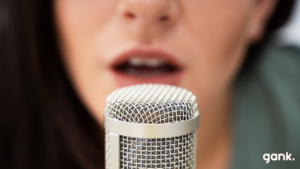Are you tingling with excitement when seeing light patterns in random movement? Or are you feeling good when you hear some crackling sound? If you are, then you might have experienced ASMR. What is ASMR?
ASMR stands for an autonomous sensory meridian response. It’s a unique feeling that some people get when they hear certain sounds or see specific sights.
Although it may be strange for some people who never feel such sensation, ASMR Popularity has increased over the last few years. Is it good or bad?
We’ll find it out in this blog post. But first, let’s break down the ASMR definition and what triggers it.
Contents :
ToggleWhat Is ASMR?
ASMR is short for an autonomous sensory meridian response. It refers to a physical sensation triggered by unique, personally-preferred sights and sounds.
The sensation can emerge from something simple, like hearing someone whispering or eating crunchy fruits. Sometimes, watching someone perform a task slowly can trigger the sensation, too.

The ones who experience ASMR will feel stimuli starting at the top of their head and moving down through their body. This makes them feel relaxed. Some even called it a brain orgasm.
ASMR was coined by Jennifer Allen in 2010 when creating a Facebook group for people who experience such aural and visual, weird sensations.
It started with steadyhealth.com’s discussion, which Jennifer was involved in. Some people in the discussion said that they had tingling feelings for many years without knowing what it was. That was exactly what Jennifer felt.
The term ASMR is used to make the discussion go further without fear of ridicule.
What Triggers ASMR?
While the sensation from ASMR seems to happen involuntarily, it happens because of specific triggers. There are at least 28 ASMR triggers out there. Some of them are:
1. Whisper
We all know that our modern life is saturated with noisy traffic, electronics, and construction sounds. That can be really overwhelming.
So, it can be understood how a low-intensity sound like a whisper can provide calmness. When we hear a whisper, it creates a soothing effect on our bodies.
Also, whispering is an act of speaking in a low voice because someone trusts you or you’re close to them. This can build an intimate and comforting situation.
This kind of personal connection with whispering can help us relax more. Eventually, when we hear a whisper, we always expect a sense of calm. This is what triggers ASMR in many people over and over again.
2. Repetitive Movements
Some people experience ASMR in response to repetitive movements. For example, the motion of a fan or the steady ticking of a clock.

This is because of the rhythmic sounds or repetitive views that can provoke a sense of calm and relaxation. This promotes focus and is often used for meditation, too.
In a more straightforward form, this repetition often involves tapping objects on certain surfaces, like glass, wood, plastic, or metal.
Many content creators on YouTube use this approach for their ASMR channel. To make the effects more lively, they use a great stereo recording to make it more immersive.
That will sound like unique music for some people and it feels like soothing them. Not only the distinctive sound but also the specific tapping tempo that can trigger great auditory or visual experiences.
3. Mouth Sounds
Mouth sounds include chewing, lip-smacking, or even breathing or blowing sounds. For those with ASMR, these sounds can evoke ineffable good feelings.
In fact, people who experience ASMR don’t care much if the sound is real or artificial. So, even the fake sound of eating noises like chewing gum or eating crunchy vegetables will still trigger ASMR.
These sounds can be relaxing and enjoyable for those who like this kind of sound experience.
4. Personal Attention
When someone is brushing your hair or drawing some cute picture on your palm, you will feel an ASMR sensation, too. Why is that?
Most of the time, it’s not about the touch but the good feeling that someone cares about you. The feeling of being cared for and pampered can be very relaxing.
It’s almost in the same sense as whispering. Personal attention evokes a sense of connection and trust.
This is why ASMR videos that contain personal attention triggers often gain the most popularity. The content involves role-playing where the ASMRtist pretends to perform a specific service for the viewer.
Read : How to Create ASMR Videos
5. Light Patterns
You heard that right. Light patterns can trigger ASMR, too. While the audio experience is more common, seeing specific lightning patterns can comfort some people with ASMR.
Well, nothing too fancy about this. Usually, people with ASMR will consume YouTube videos that use a flashlight or particular colorful light in a random movement repeatedly.
These movements can create a hypnotic effect that makes them fall asleep faster.
How Does ASMR Work?
Some people are still curious about how ASMR works. They even ask if it works for real. Well, there is no clear answer for that as the studies about it continue.
Research showed that areas of the brain associated with emotional arousal are activated with such typical audio and visual stimuli. That’s why people feel better when experiencing this ASMR.
Some people might associate how ASMR works with Frisson. In fact, they are different despite the similarities that they have.
If you get goosebumps when you hear certain music, that’s an example of Frisson. ASMR is usually not triggered by music. Adding to that, the sensation of Frisson is more to the whole body, while ASMR is much more focused on the head, neck, and spine.
Another research suggests that ASMR may be related to the release of neurotransmitters in the brain, like serotonin and oxytocin. Those two hormones are the ones that make people feel relaxed.
While ASMR might happen to people differently, it usually deals with a good feeling. It has even been reported that ASMR can help people with stress, anxiety, and insomnia.
Some people argue that ASMR is a way to reduce stress or get their mood better. They said that by watching ASMR videos, for example, they can feel relaxed. With this sensation, they believe they can prevent their body from producing cortisol, a hormone associated with stress.
However, this needs to be verified further scientifically.
The Benefits of ASMR
If you experience ASMR, what are the benefits? Is it helpful or harmful?
1. Stress Relief
Some people might not get it why watching someone folding towels for 20 minutes can make them better.
In fact, ASMR is a unique phenomenon with real impact. According to a study, ASMR has been shown to have a calming effect on the body. This helps to reduce feelings of stress and anxiety.
Again, this is due to serotonin and oxytocin release during an ASMR experience.
2. Better Sleep
ASMR can help to induce feelings of relaxation. This is helpful for those who have trouble falling asleep.
A study shows that 82% of people with the ASMR media as a sleep aid can sleep faster. Also, 81% of people who experience ASMR preferred to listen to or watch something that can trigger it before sleep.
What’s more, it can improve sleep quality and even reduce insomnia symptoms.
3. Pain Management
Some studies have suggested that ASMR may be helpful for our health, like managing our pains in a certain condition.
How so? There are reasons for this.
Firstly, ASMR triggers activate the parasympathetic nervous system. This system is responsible for promoting rest and relaxation in the body. So, someone will have a decrease in heart rate and blood pressure and will be hindered from any discomfort.
Secondly, the so-called “braingasm” seems to be effective in making someone distracted from the pain they feel. The ASMR can make them more focused on the pleasant sensation they experience.
4. Enhanced Focus
People might have a better focus when experiencing ASMR, especially with the trigger of ambient noise.
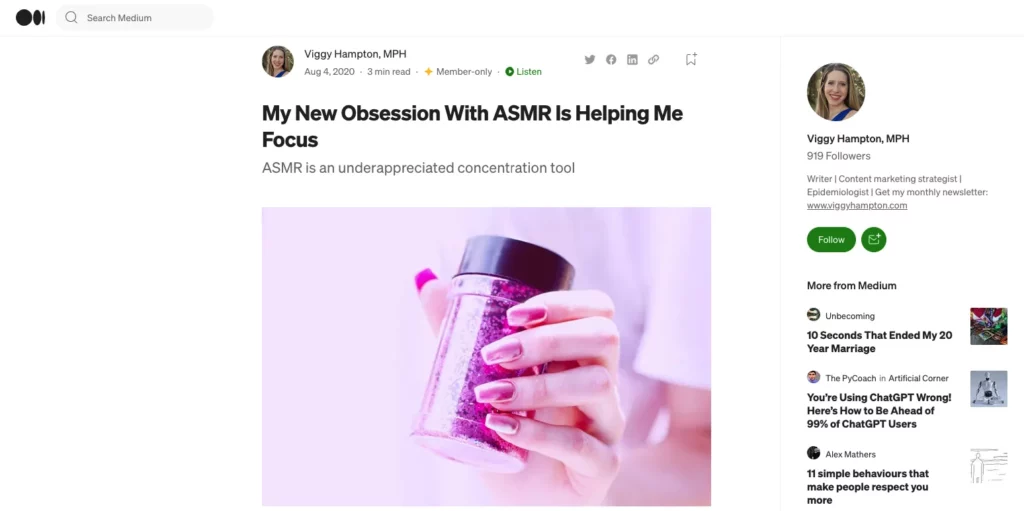
Yes, many people testify that they even use ASMR to make their concentration stronger.
Sometimes people will listen to a specific sound while working. For example, the sound of someone’s brushing their hair or even writing Chinese characters on a chalkboard.
Don’t take it for granted; those people have proved it works for them and enhances their productivity.
What is ASMR Video?
There are many advantages of ASMR according to people who experience it. Most of them get the triggers from natural experiences or videos.
As it deals with aural and visual sensations, videos are a great medium for getting such stimuli nowadays. In fact, ASMR videos have become a trend in recent years on YouTube and other platforms.
What is ASMR video? ASMR videos are online content created to stimulate ASMR. Content creators may whisper, squeeze some object to produce a crackling sound, move their hand slowly, and anything like that.
These various media trigger the ASMR response in many, causing the person to relax, be comforted, and even fall asleep.
If you think this kind of content won’t gain much audience, think again. The fact is an ASMR channel like Hongyu ASMR can have 14.9 million subscribers on YouTube, with an average of 709.000 views per video.
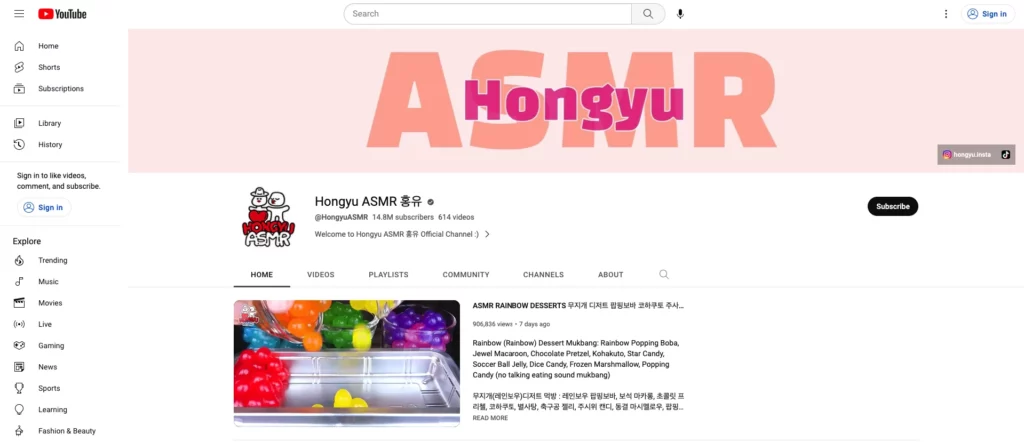
Some other popular ASMR channels on YouTube are:
- ASMR Darling – has over 3 million subscribers, with various ASMR content, from whispering, to roleplaying.
- Gentle Whispering ASMR – full of relaxing and soothing content, including soft spoken videos from a Russian ASMRtist.
- Gibi ASMR – gaining 2 million subscribers for its creative and entertaining content about all ASMR
- ASMR Glow – loved because of its ASMR content like tapping and scratching, and is known for its immersive content.
- ASMR PPOMO – known for its unique and creative videos which focus on soothing and calming vibes.
You want to be the next YouTuber that has lots of ASMR content? If you’re looking for a place to start, learn how to do good ASMR to get inspiration.
Read :
ASMR artists have gained huge popularity online in recent years. Do you have a favorite?…
ASMR is a fascinating phenomenon that brings deep relaxation and delightful scalp tingling. This unique…
We’re all familiar with the calming and soothing effects of ASMR, but it’s essential to…
There are lots of reasons why you should make ASMR videos. Some people use them…
Conclusion
What does ASMR stand for? ASMR stands for Autonomous Sensory Meridian Response. It is a physical sensation that happens because of a tingling feeling in the scalp, neck, and down the back.
Not all people will experience ASMR. Even if they do, they will have different triggers for such sensations. However, the most common triggers are hearing certain sounds like a whisper or random weird sounds in low intensity.
Nowadays, it is easier for people to experience ASMR. Not only from the natural sounds they hear but also from many YouTube videos. Most videos are created especially for ASMR as a niche.
For content creators, ASMR is a niche with a promising future for specific communities or people.
FAQs
What does ASMR mean?
ASMR stands for Autonomous Sensory Meridian Response. This is a tingling sensation some people experience in response to specific sounds and visuals.
What are ASMR triggers?
ASMR triggers are specific sounds or sights that can produce the tingling sensation. Some common triggers include whispering, tapping, and light patterns.
Is ASMR a good thing?
ASMR is a personal experience, with some people finding it calming. ASMR videos can be used for relaxation and sleep. However, some may have negative reactions to certain triggers.
Can anyone experience ASMR?
Well, not everyone experiences ASMR. However, it is estimated that up to 80% of people may be able to experience the physical sensation.
What kind of people are affected by ASMR?
Those who are more likely to experience ASMR share some common traits, including high levels of openness, empathy, sensory processing sensitivity, and relaxation.
Is ASMR safe?
Yes, ASMR is considered to be safe. However, if you feel discomfort while watching ASMR videos, stop doing it and consult a doctor.


